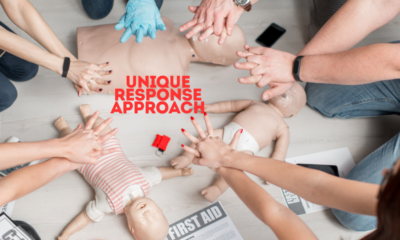Education
How Long Does It Take To Complete HBDI?

For those who are unaware, Whole Brain Thinking has been amidst us since the early 1970s. To give a brief idea, the learning model concentrates on the thinking preferences of people. Furthermore, it serves to educate learners and train professionals on the brain’s various facets and aspects when learning. It’s noteworthy mentioning that Whole Brain Thinking is exceptionally popular and is one of the most common approaches to learning.
Moreover, the learning model can help you to determine the most efficient WHS training practices- this essentially improves your eLearning with greater impact and engagement. The model is easy to understand, so even beginners comprehend the insights and implement the practices of this theory.
What Is Whole Brain Thinking?
If you are new to the overall concept of Whole Brain Thinking, the learning model essentially separates the human brain into four quadrants. These quadrants individually represent a different part of the brain- such as Practical, Analytical, Relational, and Experimental. Experts have claimed that although people have these quadrants, every human has a preferred thought process without even realizing it.
To put it simply, many prefer thinking out of the box, whereas others look for straight-up facts. This essentially explains why learners sometimes develop in certain areas while struggling in others. Whole Brain Thinking suggests learners create specific learning methods that essentially put all areas of the brain into a workout.
In this way, you would be better poised to use the stronger side of the brain while also pushing the limits on the less dominant sides. Many have admitted that this contributes to improving the WHS training to be more engaging. This is essential since it caters to every learner while boosting their chances of success.
Whole Brain Thinking In eLearning
If you are an organization delivering training, you will find it most unlikely to determine the learning style that ideally suits your learners. This is especially if your external learners prefer partners or customers. Moreover, it’s all the more unlikely that your learners will align collectively into one single quadrant.
However, what you can do is create WHS training that promises a superior impact on your learners. You can effectively achieve this by engaging every part of your learner’s brain. One can always integrate different elements for engaging the quadrants- through smart eLearning techniques. Furthermore, this can also help your learners in improving their ‘weaker’ quadrants.
Learning For Each Part of the Brain
Here’s a detailed breakdown of some key learning techniques favored by each quadrant. This will essentially benefit you for developing a universally engaging learning experience, best profiled by Hermann brain dominance instrument.
Logical: Quadrants that prefer logical learning can be best categorized as the facts and figures fans. They typically prefer proof points when it comes to learning. Moreover, they respond well to learning objectives and long-term goals while following a clear and concise way.
Organized: Similarly, quadrants that fancy the organized way of learning can be categorized as the rule followers. They tend to do well with order and procedure. Taking a leaf out from quadrant A, these quadrants also prefer performing to goal-oriented learning. They typically lookout for plans and preparation, learn via quizzes and follow instructions with practical feedback.
Emotional: Thirdly, there are the quadrants that prefer the emotional learning technique. They can be best summed up as ‘people persons’. This is essential since they tend to be emotionally in tune and empathic. Furthermore, they also show an inclination towards learning collectively with other people.
Holistic: Finally, quadrants that show the best response towards holistic learning techniques can be best categorized as a creative bunch. They concentrate deeply on the abstract and indicate a massive preference for minimal details. However, experts have admitted that they like to explore ideas. Simply put, thought exercises and idea generations are integral to their learning best.
Incorporating Whole Brain Thinking
There’s no doubting that including Whole Brain Thinking techniques consumes time- especially if you integrate the particular thinking model into how you train your learners. At the same time, the process takes time; it the entire more essential since it benefits your learners. Moreover, the process is not that complicated since each faction has some crossover. Therefore, you can develop learning that involves your learners.
- Analyze Your Current Training Strategy
Survey reports primarily suggest that most training strategies severely rely on the same learning elements. You could consider your primary training data-heavy courses with a quiz, text-based, or regular webinars. Under most scenarios, you will find great help in digging deep into your most regularly used strategies. This is fundamental since it will help you get insight into all quadrants you’re catering to.
- Concentrate on Strategising the Incorporation of Whole Brain Practices
Up next, you must focus on developing content that involves all the quadrants to guarantee maximum engagement. You may have a data-based training strategy to paint a pretty picture for this, which is always a sophisticated way to learn for quadrant A. You can still improve this practice for more engagement. This is essentially possible by developing graphics with interactive data.
When it comes to quadrants B and C, there are plenty of studies that can put context and bring the story you’re providing to life. Furthermore, you can always encourage feedback in person or through your LMS. This will promote quadrant C and D learners to explore the ideas further between the instructors and learners or just between the learners.
- Test and Iterate
If you are new to the whole concept, you must fast realize that the trick with Whole Brain Thinking is to test your training with the Hermann brain dominance instrument. It is essential to mention that relentlessly reinventing your training techniques, recording positive reactions from the learners, and making necessary adjustments to the training is key to fostering the learners and furthering engagement.
Test Whole Brain Thinking
Finally, when it comes to corporate enterprises looking for better learning results, they must put the Whole Brain Thinking into use. There’s no doubting that Whole Brain Thinking is a tremendous practice that can contribute significantly, especially with Hermann’s brain dominance instrument. Regardless of whether you choose to reassess your learning methods to cater to wider learning techniques or make all of your current learning whole brains.
-

 Press Release4 days ago
Press Release4 days agoClinical Trials Market Set for Robust Growth, Driven by Drug Development Surge and Digital Innovation
-

 Press Release5 days ago
Press Release5 days agoFill-Finish Pharmaceutical Contract Manufacturing Market Expected to Flourish Amid Biopharmaceutical Boom and Global Outsourcing Trend by 2035
-

 Business6 days ago
Business6 days agoHow Managed IT Solutions Help Small Teams Compete at Enterprise Scale
-

 Press Release5 days ago
Press Release5 days agoGreen Bio Chemicals Market Poised for Sustainable Growth amidst Global Shift to Eco-Friendly Alternatives by 2035
-

 Press Release5 days ago
Press Release5 days agoIndustrial Boiler Market Expected to Surpass USD 24.4 Billion by 2035 Amid Growing Demand for Energy Efficiency and Industrialization
-

 Press Release5 days ago
Press Release5 days agoPreventive Vaccines Market to Witness Strong Growth by 2035
-

 Press Release5 days ago
Press Release5 days agoPet Food Nutraceutical Market Set for Robust Expansion Amid Rising Demand for Pet Wellness by 2035
-

 Press Release4 days ago
Press Release4 days agoWaterproof Structural Adhesives Market: A Comprehensive Study Towards USD 10.3 Billion in 2035






























